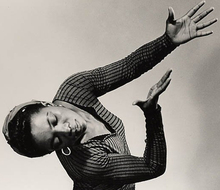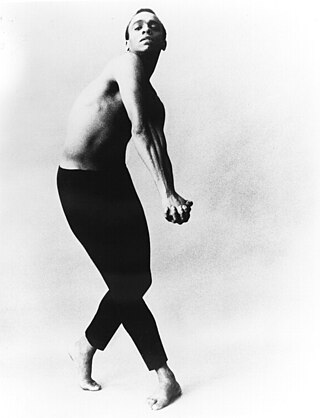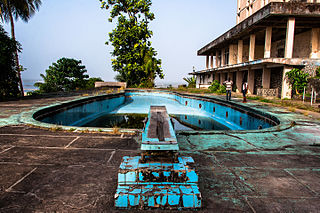Jazz is a music genre that originated in the African-American communities of New Orleans, Louisiana, in the late 19th and early 20th centuries, with its roots in blues and ragtime. Since the 1920s Jazz Age, it has been recognized as a major form of musical expression in traditional and popular music. Jazz is characterized by swing and blue notes, complex chords, call and response vocals, polyrhythms and improvisation. Jazz has roots in European harmony and African rhythmic rituals.

Yasiin Bey, formerly known as Mos Def, is an American rapper, singer, songwriter, and actor. A prominent figure in conscious hip hop, he is recognized for his use of wordplay and commentary on social and political issues, such as police brutality, American exceptionalism, and the social status of African Americans.

Pearl Eileen Primus was an American dancer, choreographer and anthropologist. Primus played an important role in the presentation of African dance to American audiences. Early in her career she saw the need to promote African dance as an art form worthy of study and performance. Primus' work was a reaction to myths of savagery and the lack of knowledge about African people. It was an effort to guide the Western world to view African dance as an important and dignified statement about another way of life.

Panama Hattie is a 1940 American musical with music and lyrics by Cole Porter and book by Herbert Fields and B. G. DeSylva. The musical is about a nightclub owner, Hattie Maloney, who lives in the Panama Canal Zone and ends up dealing with both romantic and military intrigue. The title is a play on words, referring to the popular Panama hat.

African dance refers to the various dance styles of sub-Saharan Africa. These dances are closely connected with the traditional rhythms and music traditions of the region. Music and dancing is an integral part of many traditional African societies. Songs and dances facilitate teaching and promoting social values, celebrating special events and major life milestones, performing oral history and other recitations, and spiritual experiences. African dance uses the concepts of polyrhythm and total body articulation. African dances are a collective activity performed in large groups, with significant interaction between dancers and onlookers in the majority of styles.

Donald McKayle was an American modern dancer, choreographer, teacher, director and writer best known for creating socially conscious concert works during the 1950s and '60s that focus on expressing the human condition and, more specifically, the black experience in America. He was "among the first black men to break the racial barrier by means of modern dance." His work for the concert stage, especially Games (1951) and Rainbow Round My Shoulder (1959), has been the recipient of widespread acclaim and critical attention. In addition, McKayle was the first black man to both direct and choreograph major Broadway musicals, including the Tony Award-winners Raisin (1973) and Sophisticated Ladies (1981), and he worked extensively in television and film. As a young man he appeared with some of the twentieth century's most important choreographers, including Martha Graham, Anna Sokolow, and Merce Cunningham, and in some of Broadway's landmark productions, including House of Flowers (1958) and West Side Story (1957), where he served for a time as the production's dance captain. A Tony Award and Emmy Award nominee, McKayle held an endowed chair for the last decades of his life in the Dance Department at UC Irvine, where he was the Claire Trevor Professor of Dance. He previously served on the faculties of Connecticut College, Sarah Lawrence College, and Bennington College.

African-American dance is a form of dance that was created by Africans in the Diaspora, specifically the United States. It has developed within various spaces throughout African-American communities in the United States, rather than studios, schools, or companies. These dances are usually centered on folk and social dance practice, though performance dance often supplies complementary aspects to this. Placing great value on improvisation, these dances are characterized by ongoing change and development. There are a number of notable African-American modern dance companies using African-American cultural dance as an inspiration, among these are the Whitey's Lindy Hoppers, Alvin Ailey American Dance Theater, Dance Theatre of Harlem, and Katherine Dunham Company. Hollywood and Broadway have also provided opportunities for African-American artists to share their work and for the public to support them.
Austin Dafora Horton, also known as Asadata Dafora, was a Sierra Leonean multidisciplinary musician. He was one of the first Africans to introduce African drumming music to the United States, beginning in the early 1930s. His artistic endeavours spanned multiple disciplines, but he is best remembered for his work in dance and music.
DanceAfrica is a heritage and community celebration equable on the manifold dance forms of the African Diaspora held annually in New York City, Washington, DC, and Chicago. Included are indoor and outdoor performance including live music, a film series, master classes, education programs, and an outdoor bazaar. Its current artistic director is Abdel R. Salaam.

Café Society was a New York City nightclub open from 1938 to 1948 on Sheridan Square in Greenwich Village. It was managed by Barney Josephson.

The Asante Empire, today commonly called the Ashanti Empire, was an Akan state that lasted from 1701 to 1901, in what is now modern-day Ghana. It expanded from the Ashanti Region to include most of Ghana and also parts of Ivory Coast and Togo. Due to the empire's military prowess, wealth, architecture, sophisticated hierarchy and culture, the Ashanti Empire has been extensively studied and has more historic records written by European, primarily British, authors than any other indigenous culture of sub-Saharan Africa.

Drums of Passion is an album produced by Babatunde Olatunji, a percussionist from Nigeria, in 1960. It was the first recording to popularize African music in the West, becoming immensely successful and selling over five million copies. In 2002, it was released as a single layer stereo and 5.1 SACD by Columbia Records. In 2004 the album was added to the National Recording Registry.
Nana Kimati Dinizulu was an American virtuoso percussionist, widely acclaimed for his artistry with African percussion. He wrote works in the areas of jazz, folk, classical, popular, ballet, and musical theater.

Modern dance is a broad genre of western concert or theatrical dance which includes dance styles such as ballet, folk, ethnic, religious, and social dancing; and primarily arose out of Europe and the United States in the late 19th and early 20th centuries. It was considered to have been developed as a rejection of, or rebellion against, classical ballet, and also a way to express social concerns like socioeconomic and cultural factors.

The Ducor Hotel is an abandoned luxury hotel in Monrovia, Liberia. Established in 1960, it had 106 rooms on eight stories. The hotel has fallen into disrepair after being occupied by squatters who were removed before a failed effort at a Libyan-funded renovation. The building sits on Ducor Hill, the highest point of the city, overlooking the Atlantic Ocean, the Saint Paul River and Monrovia's West Point district. It is located at the end of Broad Street across from United Nations Boulevard in Monrovia's main business district.

Revelations is the best-known work of the modern dance choreographer Alvin Ailey. It is also the signature work of the Alvin Ailey American Dance Theater, which premiered an extended version of the work in 1960, when Ailey was 29 years old. Set to spirituals, gospel, and blues music and influenced by the choreographer's own Christian upbringing, it presents a vision of the historical African American experience from a church-inspired perspective. The three sections of the final 36-minute revised version depict the suffering of slavery, baptismal joy, and a choral church celebration.
Marimba Ani is an anthropologist and African Studies scholar best known for her work Yurugu, a comprehensive critique of European thought and culture, and her coining of the term "Maafa" for the African holocaust.

Constance Cummings-John was a Sierra Leonean educationist and politician. She was the first woman in Africa to join a municipal council and in 1966 became the first woman to serve as mayor of Freetown, Sierra Leone. She was based in London, England, for the latter part of her life.
Charles Moore was an African-American dancer, choreographer, teacher and founder of The Charles Moore Dance Theatre in Brooklyn, New York.
Ismay Andrews was one of the earliest major teachers of African dance in the United States. Her career started in 1929 as a stage actress, and she taught dance in community centers in New York City from 1934 to 1959.












